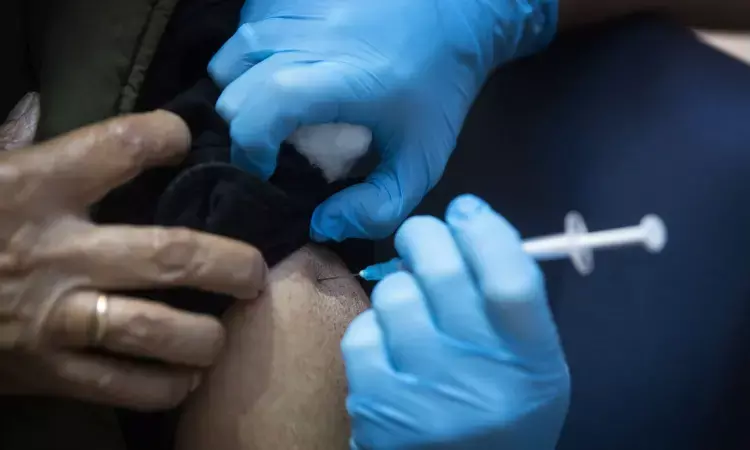- Home
- Medical news & Guidelines
- Anesthesiology
- Cardiology and CTVS
- Critical Care
- Dentistry
- Dermatology
- Diabetes and Endocrinology
- ENT
- Gastroenterology
- Medicine
- Nephrology
- Neurology
- Obstretics-Gynaecology
- Oncology
- Ophthalmology
- Orthopaedics
- Pediatrics-Neonatology
- Psychiatry
- Pulmonology
- Radiology
- Surgery
- Urology
- Laboratory Medicine
- Diet
- Nursing
- Paramedical
- Physiotherapy
- Health news
- Fact Check
- Bone Health Fact Check
- Brain Health Fact Check
- Cancer Related Fact Check
- Child Care Fact Check
- Dental and oral health fact check
- Diabetes and metabolic health fact check
- Diet and Nutrition Fact Check
- Eye and ENT Care Fact Check
- Fitness fact check
- Gut health fact check
- Heart health fact check
- Kidney health fact check
- Medical education fact check
- Men's health fact check
- Respiratory fact check
- Skin and hair care fact check
- Vaccine and Immunization fact check
- Women's health fact check
- AYUSH
- State News
- Andaman and Nicobar Islands
- Andhra Pradesh
- Arunachal Pradesh
- Assam
- Bihar
- Chandigarh
- Chattisgarh
- Dadra and Nagar Haveli
- Daman and Diu
- Delhi
- Goa
- Gujarat
- Haryana
- Himachal Pradesh
- Jammu & Kashmir
- Jharkhand
- Karnataka
- Kerala
- Ladakh
- Lakshadweep
- Madhya Pradesh
- Maharashtra
- Manipur
- Meghalaya
- Mizoram
- Nagaland
- Odisha
- Puducherry
- Punjab
- Rajasthan
- Sikkim
- Tamil Nadu
- Telangana
- Tripura
- Uttar Pradesh
- Uttrakhand
- West Bengal
- Medical Education
- Industry
SARS-CoV-2 infection tied to higher risk of Bell Palsy: JAMA

Iran: A recent study published in JAMA Otolaryngology-Head & Neck Surgery has revealed an association between SARS-CoV-2 and Bell palsy (BP).
The systematic review and meta-analysis suggest a higher incidence of Bell palsy in those vaccinated against COVID-19 versus placebo groups. The researchers, however, found no significant difference between recipients of the Oxford/AstraZeneca versus Pfizer/BioNTech vaccine. Further, SARS-CoV-2 infection poses a significantly higher risk of BP than SARS-CoV-2 vaccination.
Notably, SARS-CoV-2 infection was tied to a 3.23-fold increased BP risk compared with SARS-CoV-2 vaccines, favouring the vaccine's protective role in reducing the BP incidence associated with exposure to SARS-CoV-2.
Bell palsy, idiopathic facial nerve palsy, is the most common cause of acute spontaneous peripheral facial paralysis. Its reported annual incidence rate is 15 to 30 cases per 100 000 population. There is no clarity on the exact cause of BP, but viral infections (such as herpes simplex virus), inflammation, and ischemia are some underlying mechanisms.
Bell palsy has also been reported as an adverse event after the SARS-CoV-2 vaccination. Still, studies have not been able to establish either a higher prevalence or a causative relationship than in the general population. Therefore, Ali Rafati, Iran University of Medical Sciences, Tehran, and colleagues aimed to compare the incidence of Bell palsy in the recipients of the SARS-CoV-2 vaccine versus unvaccinated individuals or placebo recipients.
For this purpose, the researchers searched the online databases from the inception of the COVID-19 report to August 15, 2022. Articles reporting the incidence of BP with SARS-CoV-2 vaccination were included.
The study's primary outcomes were to compare BP incidence among (!) recipients of SARS-CoV-2 vaccine, (2) nonrecipients in the unvaccinated or placebo cohorts, (3) different types of SARS-CoV-2 vaccines, and (4) SARS-CoV-2–infected versus SARS-CoV-2–vaccinated individuals.
The study led to the following findings:
- Of the fifty studies included, 17 entered the quantitative synthesis.
- Pooling 4 phase 3 randomized clinical trials revealed significantly greater BP in SARS-CoV-2 vaccine recipients (77 525 vaccine recipients vs 66 682 placebo recipients; odds ratio [OR], 3.00).
- However, there was no significant increase in BP after administering the messenger RNA SARS-CoV-2 vaccine in pooling eight observational studies (13 518 026 doses vs 13 510 701 unvaccinated; OR, 0.70).
- No significant difference was found in BP among 22 978 880 first-dose recipients of the Pfizer/BioNTech vaccine compared with 22 978 880 first-dose recipients of the Oxford/AstraZeneca vaccine (OR, 0.97).
- Bell palsy was significantly more common after SARS-CoV-2 infection (n = 2 822 072) than after SARS-CoV-2 vaccinations (n = 37 912 410) (relative risk, 3.23).
"Our findings demonstrate evidence for the association between SARS-CoV-2 and BP; however, this finding does not equate to causality," the researchers conclude. "Further research is needed to validate this association and investigate possible mechanisms."
Reference:
Rafati A, Pasebani Y, Jameie M, et al. Association of SARS-CoV-2 Vaccination or Infection With Bell Palsy: A Systematic Review and Meta-analysis. JAMA Otolaryngol Head Neck Surg. Published online April 27, 2023. doi:10.1001/jamaoto.2023.0160
Dr Kamal Kant Kohli-MBBS, DTCD- a chest specialist with more than 30 years of practice and a flair for writing clinical articles, Dr Kamal Kant Kohli joined Medical Dialogues as a Chief Editor of Medical News. Besides writing articles, as an editor, he proofreads and verifies all the medical content published on Medical Dialogues including those coming from journals, studies,medical conferences,guidelines etc. Email: drkohli@medicaldialogues.in. Contact no. 011-43720751


